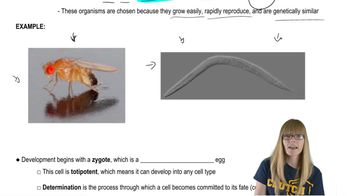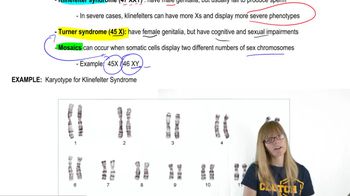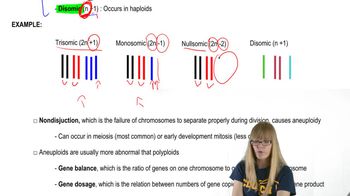Table of contents
- 1. Introduction to Genetics51m
- 2. Mendel's Laws of Inheritance3h 37m
- 3. Extensions to Mendelian Inheritance2h 41m
- 4. Genetic Mapping and Linkage2h 28m
- 5. Genetics of Bacteria and Viruses1h 21m
- 6. Chromosomal Variation1h 48m
- 7. DNA and Chromosome Structure56m
- 8. DNA Replication1h 10m
- 9. Mitosis and Meiosis1h 34m
- 10. Transcription1h 0m
- 11. Translation58m
- 12. Gene Regulation in Prokaryotes1h 19m
- 13. Gene Regulation in Eukaryotes44m
- 14. Genetic Control of Development44m
- 15. Genomes and Genomics1h 50m
- 16. Transposable Elements47m
- 17. Mutation, Repair, and Recombination1h 6m
- 18. Molecular Genetic Tools19m
- 19. Cancer Genetics29m
- 20. Quantitative Genetics1h 26m
- 21. Population Genetics50m
- 22. Evolutionary Genetics29m
6. Chromosomal Variation
Chromosomal Mutations: Aneuploidy
Problem 19
Textbook Question
In humans that are XX/XO mosaics, the phenotype is highly variable, ranging from females who have classic Turner syndrome symptoms to females who are essentially normal. Likewise, XY/XO mosaics have phenotypes that range from Turner syndrome females to essentially normal males. How can the wide range of phenotypes be explained for these sex-chromosome mosaics?
 Verified step by step guidance
Verified step by step guidance1
<span>Understand the concept of mosaicism: Mosaicism occurs when an individual has two or more populations of cells with different genotypes. In the case of XX/XO or XY/XO mosaics, some cells have two sex chromosomes (XX or XY), while others have only one (XO).</span>
<span>Consider the role of X chromosome inactivation: In females, one of the X chromosomes is randomly inactivated in each cell, a process known as X-inactivation. This can lead to variability in the expression of X-linked genes, contributing to phenotypic differences.</span>
<span>Examine the impact of the Y chromosome: In XY/XO mosaics, the presence or absence of the Y chromosome in certain cells can influence the development of male characteristics, leading to a range of phenotypes from Turner syndrome females to normal males.</span>
<span>Explore the influence of the proportion of XO cells: The ratio of XO to XX or XY cells can affect the severity of the phenotype. A higher proportion of XO cells may result in more pronounced Turner syndrome features, while a lower proportion may lead to milder symptoms or normal development.</span>
<span>Consider the role of genetic and environmental factors: Other genetic factors, such as mutations in autosomal genes, and environmental influences can also contribute to the variability in phenotypes observed in sex-chromosome mosaics.</span>
Recommended similar problem, with video answer:
 Verified Solution
Verified SolutionThis video solution was recommended by our tutors as helpful for the problem above
Video duration:
2mPlay a video:
Was this helpful?
Key Concepts
Here are the essential concepts you must grasp in order to answer the question correctly.
Mosaicism
Mosaicism refers to the presence of two or more genetically different cell lines within an individual, resulting from mutations or chromosomal abnormalities during early development. In the context of sex-chromosome mosaics, this means that some cells may have different combinations of sex chromosomes, leading to a variety of phenotypes. This variability can significantly affect physical traits and health outcomes.
Recommended video:
Guided course

Genetics of Development
Turner Syndrome
Turner syndrome is a genetic condition that occurs in females who have only one X chromosome (45,X) or a partial X chromosome. It is characterized by features such as short stature, delayed puberty, and infertility. In mosaic cases, some cells may have the typical XX configuration, while others may have the XO configuration, leading to a spectrum of symptoms and phenotypes, from classic Turner syndrome to normal female characteristics.
Recommended video:
Guided course

Human Sex Chromosomes
Phenotypic Variability
Phenotypic variability refers to the range of observable traits or characteristics that can arise from a single genotype due to environmental influences, genetic interactions, or developmental factors. In sex-chromosome mosaics, the differing combinations of sex chromosomes in various cell lines can lead to a wide array of phenotypes, as some cells may express traits associated with one sex while others may not, resulting in a complex interplay of characteristics.
Recommended video:
Guided course

Mutations and Phenotypes
Related Videos
Related Practice




